FIBC Market Size
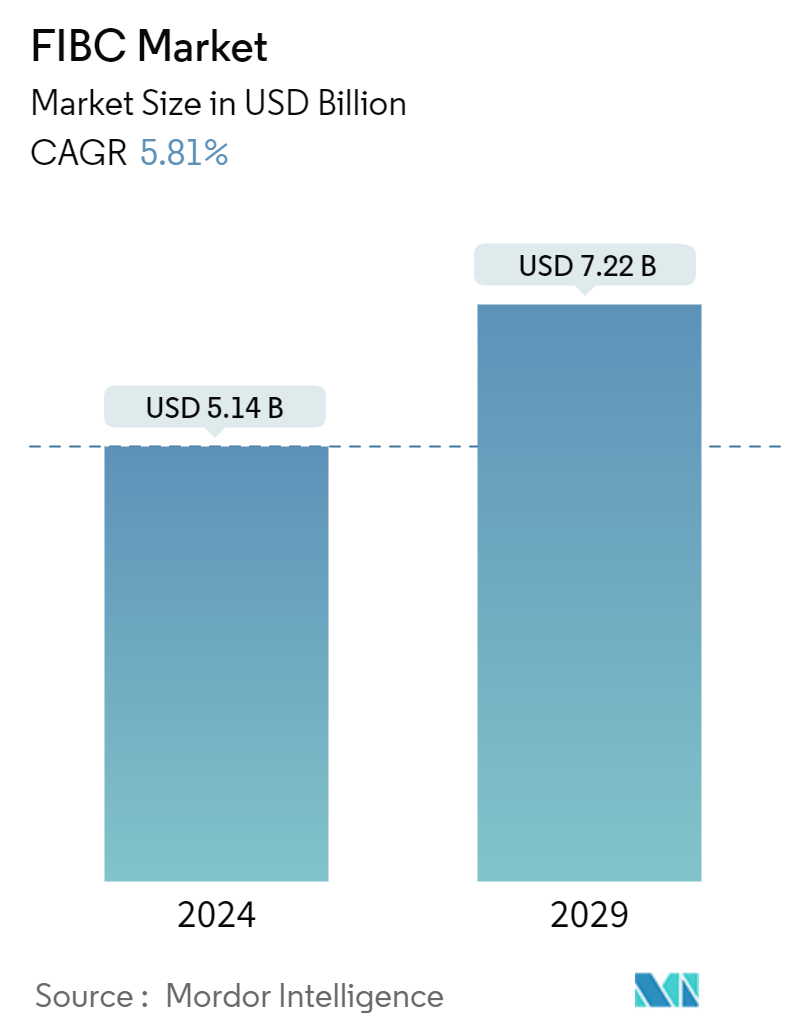
| Study Period | 2019 - 2029 |
| Market Size (2024) | USD 5.14 Billion |
| Market Size (2029) | USD 7.22 Billion |
| CAGR (2024 - 2029) | 5.81 % |
| Fastest Growing Market | Asia Pacific |
| Market Concentration | Low |
Major Players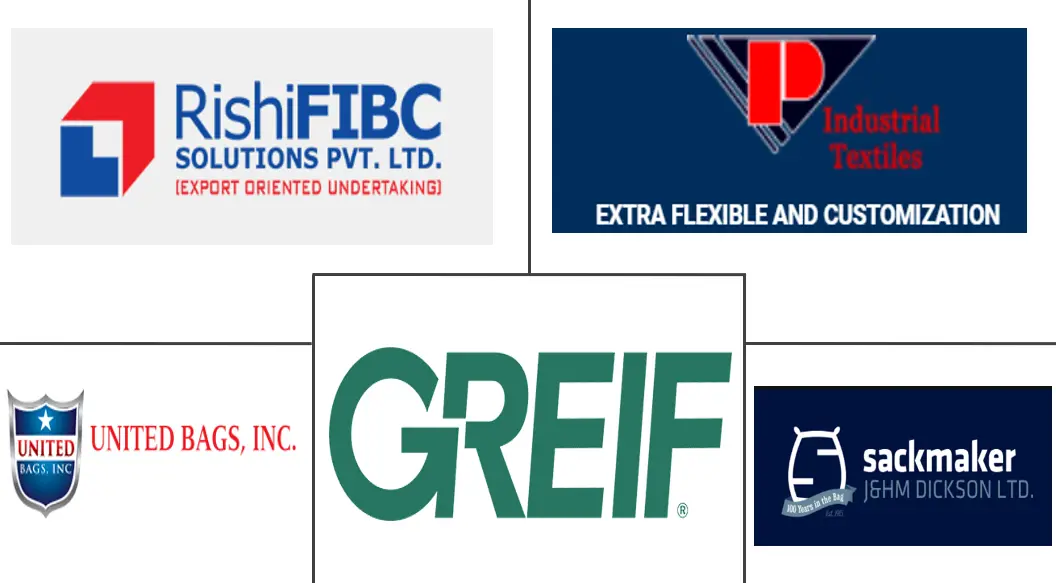
*Disclaimer: Major Players sorted in no particular order |
FIBC Market Analysis
The FIBC Market size is estimated at USD 5.14 billion in 2024, and is expected to reach USD 7.22 billion by 2029, growing at a CAGR of 5.81% during the forecast period (2024-2029).
- FIBCs are one of the fastest-growing packaging solutions in the industry. One of the main reasons for the FIBC market growth is the fast-paced industrialization in the world. Industries in the chemical industry and agriculture increasingly depend on FIBCs to transport various products, such as grain, rice, potatoes, cereals, and liquid chemicals. FIBCs also play an important role in storing and transporting construction materials, including carbon black, steel, alloys, minerals, cement, and sand.
- Automation and robotics have made a huge impact in many industries. Automation is just beginning to take hold in FIBC manufacturing. Automated production and filling processes for high-quality bulk bags are expected to be a big part of the future of FIBC marketing. In August 2023, Spiroflow, a key Automated Handling Solutions (AHS) company, introduced a next-generation twin-line bulk bag filling system. The auto-release hook and roller conveyor combine to simplify the filling process. Full bulk bags are transferred from the filler onto the conveyors smoothly and automatically. Also, automation reduces the amount of manual intervention.
- As environmental concerns increase, sustainability is now a top priority for businesses and consumers. FIBC producers and marketers are responding to the increasing demand for sustainable packaging solutions. For instance, in January 2024, Vaal Bulk Bags, a producer and supplier of cost-effective bulk bags, unveiled its focus on commitments to innovative packaging solutions with sustainability as the top priority. By focusing on environmental sustainability, the company's goal is to reduce the environmental impact of bulk packaging while preserving the quality and functionality of the products.
- Polyethylene (PE) and polypropylene (PPE) are two of the main raw materials used in most FIBCs and liners worldwide. However, raw material availability has been the most concerning issue both during and post-pandemic periods. Therefore, with disruptive market conditions (high demand, low supply), the FIBC industry witnessed a price rise. FIBC prices have witnessed significant price increases in the past few years that are being passed onto consumers.
- Further, the growth of varied industries involved in international trade is escalating the demand for FIBC or flexible bulk bags. According to the United Nations Conference on Trade and Development's (UNCTAD) most recent Global Trade Update, released on 21 June 2023, after a decline in the latter half of 2022, global merchandise trade bounced back in terms of both volume and value in early 2023. Such a rise in international trade is expected to bolster the demand for FIBC to transport goods across the world.
FIBC Market Trends
Increasing Demand from the Chemical and Petrochemical Segment
- Due to their high strength and chemical resistance, FIBC bags are essential in safely storing and transporting chemical and petrochemical materials. FIBCs are used for packaging and transporting dangerous substances such as powder, granules, and flammable materials. FIBC bags for this industry are often equipped with anti-static features and liners to avoid product contamination.
- Made from the finest polypropylene resin, FIBC bulk bags are impervious to virtually any chemical, water, contaminant, fire, or explosion. FIBC bulk bags carry various acids and bases, including sulfuric acid, sodium hydroxide, ammonia water, and bleach. Several companies across the world provide FIBC with robust capacity. For instance, FIBC jumbo bulk bags at Palmetto Industries can hold up to 4,000 pounds of several kinds of chemicals.
- Further, globalization and improved transportation networks drive cross-border trade of chemicals and petrochemicals, which drives the market. In addition, businesses are taking advantage of cross-border trade opportunities to expand their reach, diversify their revenue sources, and optimize their supply chains.
- According to the American Chemistry Council, the chemical manufacturing sector in the United States was projected to register a CAGR of 4.3% in 2022, recovering from a decrease in production in 2020 owing to the pandemic. In 2023, the sector was expected to grow by 2.1%. Such growth in chemical production is expected to widen in the upcoming years, consequently pushing down the demand for chemical packaging.
- The chemical packaging market focuses on producing and distributing packaging solutions specifically designed for storing and transporting large volumes of chemicals. These packaging solutions are designed to meet the highest safety and regulatory requirements, guaranteeing the chemical's integrity and stability throughout its life cycle. For example, UN FIBC bags are specially designed and tested for the safe transportation of hazardous materials, as they meet the UN’s performance packaging standards. These FIBCs are specially designed and tested for the safe transportation of hazardous materials, as they meet the UN’s performance packaging standards.
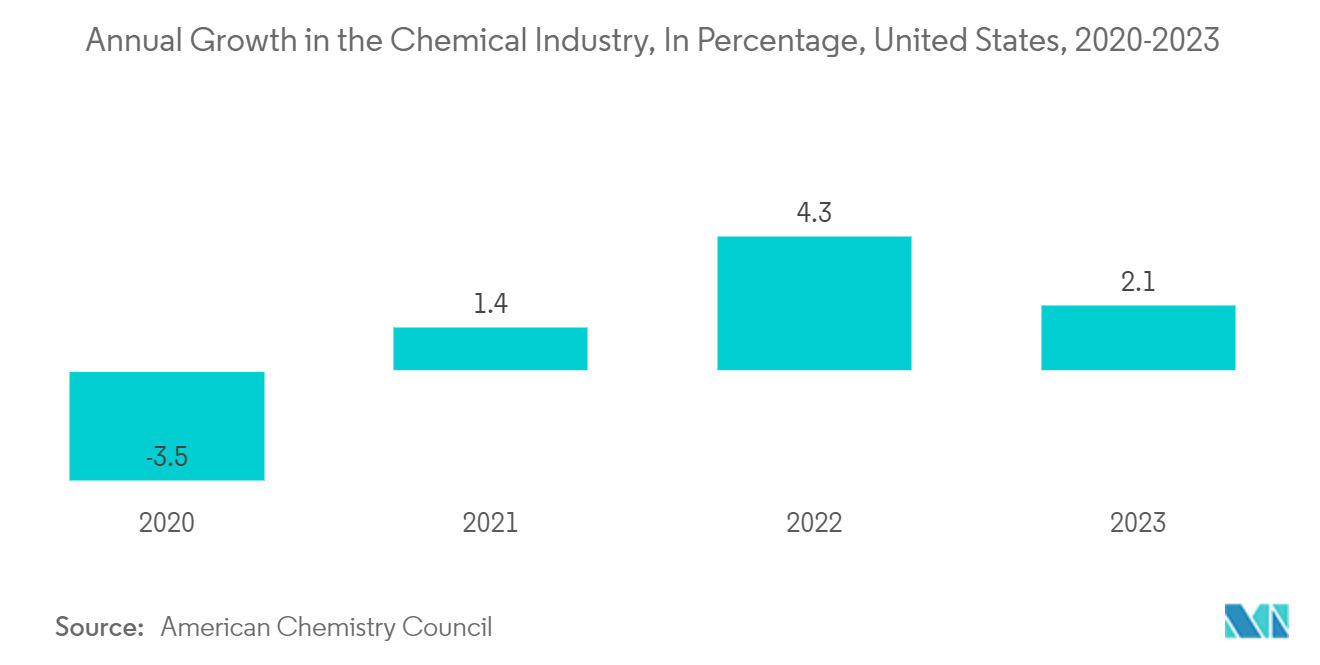
Asia-Pacific is Expected to Witness Robust Growth
- The FIBC market is expected to reach a high level in the next few years due to increasing demand from Asia and the rest of the global market. In Asia-Pacific, China is expected to hold the largest market share in intermediate bulk packaging. The growing Chinese food and beverages market is expected to contribute positively to the growth of the Asia-Pacific medium bulk liner market in the coming years.
- China is one of the world’s largest economies and one of the largest trading countries in terms of the sum of its exports and imports. The country is known as the world’s factory, and its export trade for manufactured goods is again rebounding after a sudden stagnation for a brief period. With the continued growth in the export trade, the market is expected to witness robust demand for bulk and sturdy intermediate flexible bags.
- China's exports rebounded slightly in November 2023, ending a six-month streak of decline and recovering the world's second-largest economy, according to official data published in the General Administration of Customs article in December 2023. Therefore, this consistent growth in export trade across the country would be attributed to the constant demand for industrial products as the key secondary packaging products for the export trade.
- As India's exports continue to grow, especially in the areas of food processing, pharmaceuticals, and chemicals, custom bulk packaging solutions are becoming increasingly important for Indian manufacturers. According to the India Brand Equity Foundation, the value of Indian pharmaceutical exports from India increased from USD 19.1 billion in 2019 to USD 25.4 Billion in 2023. This rising export trend is expected to have created a bolstered demand for bulk FIBC across the market.
- Governments are encouraging the use of recyclable materials for packaging in India, which is something that FIBCs can help with. There is an increasing demand for customized storage and transportation solutions for various industries, and the lack of skilled labor means that more and more FIBCs are being used due to their ease of handling and cost-effectiveness.
- According to the President of the Indian Flexible Intermediate Bulk Container Association (IFIBCA), since the inception of FIBCA, the country produced around 10,000 tons of FIBCs per year. At present, it produces 400,000 tons per year. India is one of the largest exporters of FIBCs in the world, including Europe, and the United States is one of the largest importers. The growth in production is expected to increase between 2024 and 2029 with the rising demand across the global market.
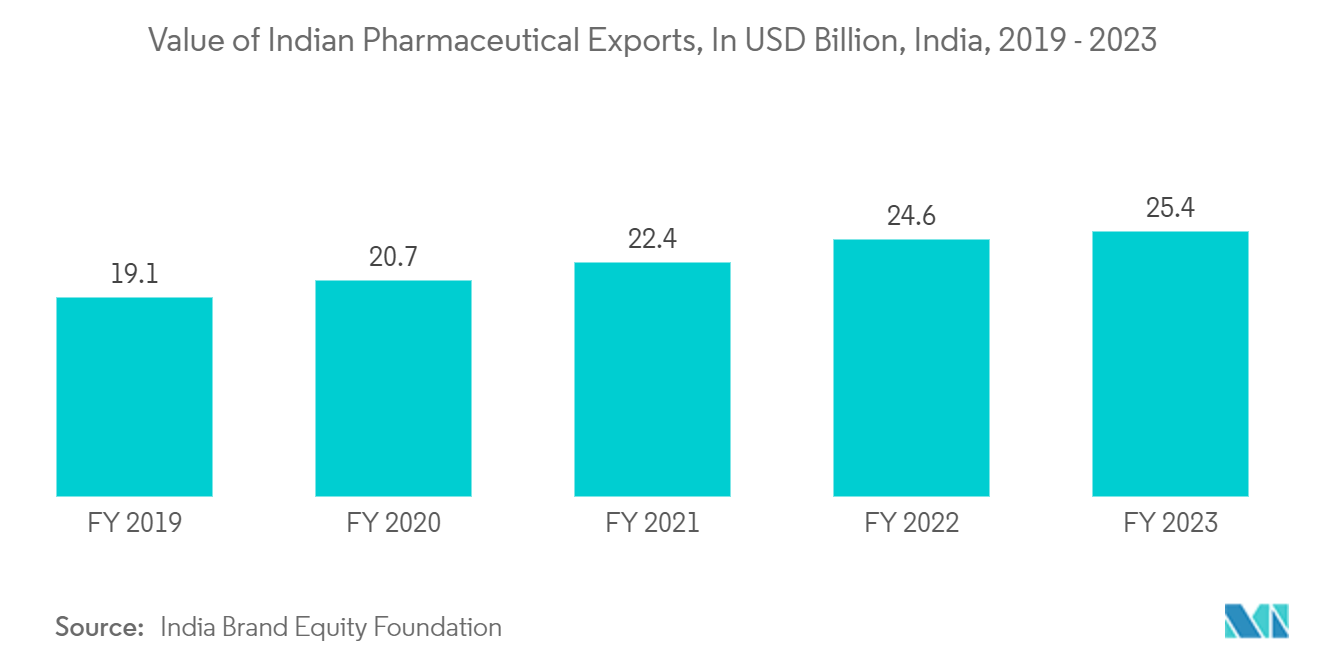
FIBC Industry Overview
The FIBC market is fragmented as it currently consists of many players. Several key players in the market are constantly making efforts to bring advancements. A few prominent companies are entering into collaborations and expanding their global footprints in developing regions to consolidate their positions in the market. The major market players are Greif Inc., United Bags Inc., Berry Global Group Inc., Rishi FIBC Solutions Pvt Ltd, and J&HM Dickson Ltd.
- In May 2023, FlexSack launched its new polypropylene sustainable, flexible intermediate bulk containers (FIBCs) containing 30% recycled PP (rPP). FlexSack-eco 2023 with 30% (PCR) is a sustainable alternative to the traditional polyethylene bag. The latest development in woven bags has evolved from a combination of polyethylene bags sewn with nylon thread to 100% recycled polypropylene bags.
- In August 2023, Australia-based family-owned business Sadleirs Packaging introduced a 100% polypropylene FIBC with 30% recyclable content for the first time in the country. As per the company’s sales manager, almost all FIBC configurations can be migrated to the new FIBC Green Bag, and the clients in the Mining, Manufacturing, Construction, Chemicals, Dairy, and other food processing sectors are eager to trial and migrate.
FIBC Market Leaders
-
Greif Inc.
-
United Bags Inc.
-
Rishi FIBC Solutions Pvt Ltd
-
Plastipak Group
-
J&HM Dickson Ltd.
*Disclaimer: Major Players sorted in no particular order
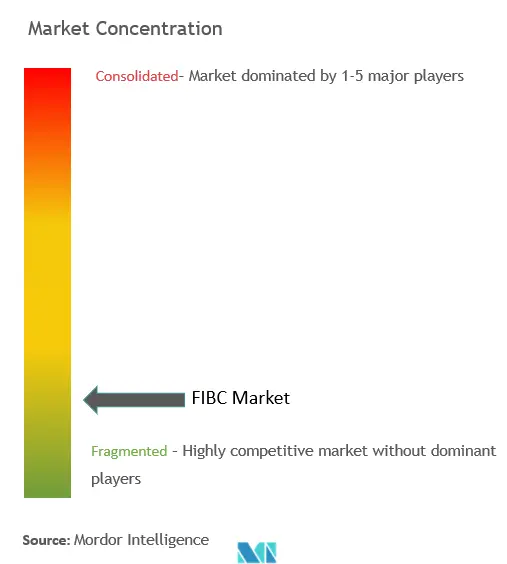
FIBC Market News
- May 2024: Kite Packaging, a player in the UK packaging sector, has unveiled a new line of Flexible Intermediate Bulk Containers (FIBC) bags. These innovative bags aim to enhance bulk handling operations across diverse industries. They are particularly adept at efficiently managing dry, pourable goods, including sand, fertilizers, chemicals, and other granular materials.
- April 2024: Packem Umasree, a collaboration between Brazil's Packem SA and India's Umasree Texplast, has launched India's inaugural plant dedicated to producing FIBC (Flexible Intermediate Bulk Container/Jumbo Bag) bags from 100% sustainable rPET (recycled polyethylene terephthalate) bottles. Leveraging advanced technology and novel methodologies, Packem Umasree is set to convert recycled PET bottles into premium FIBC bags, championing a closed-loop system that curtails waste and champions the principles of a circular economy.
FIBC Market Report - Table of Contents
1. INTRODUCTION
- 1.1 Study Assumptions and Market Definition
- 1.2 Scope of the Study
2. RESEARCH METHODOLOGY
3. EXECUTIVE SUMMARY
4. MARKET INSIGHTS
- 4.1 Market Overview
- 4.2 Industry Value Chain Analysis
-
4.3 Industry Attractiveness - Porter's Five Forces Analysis
- 4.3.1 Bargaining Power of Suppliers
- 4.3.2 Bargaining Power of Buyers/Consumers
- 4.3.3 Threat of New Entrants
- 4.3.4 Threat of Substitute Products
- 4.3.5 Intensity of Competitive Rivalry
5. MARKET DYNAMICS
-
5.1 Market Drivers
- 5.1.1 Increased Demand for Flexible Plastic Packaging Solutions across End-user Industries
- 5.1.2 Growing Utilization of Distribution Channels such as Convenience Stores and E-commerce
-
5.2 Market Restraints
- 5.2.1 Increasing Price Volatility of Raw Materials
6. MARKET SEGMENTATION
-
6.1 By Type
- 6.1.1 Type A
- 6.1.2 Type B
- 6.1.3 Type C
- 6.1.4 Type D
-
6.2 By Design Type
- 6.2.1 U-Panel Bags
- 6.2.2 Baffle Bags
- 6.2.3 Circular Bags
- 6.2.4 4-Side Panel Bags
- 6.2.5 Other Design Types
-
6.3 By End-user Industry
- 6.3.1 Food and Agricultural Products
- 6.3.2 Chemical and Petrochemical
- 6.3.3 Pharmaceutical
- 6.3.4 Other End-user Industries
-
6.4 By Geography***
- 6.4.1 North America
- 6.4.1.1 United States
- 6.4.1.2 Canada
- 6.4.2 Europe
- 6.4.2.1 United Kingdom
- 6.4.2.2 Germany
- 6.4.2.3 France
- 6.4.2.4 Italy
- 6.4.3 Asia
- 6.4.3.1 China
- 6.4.3.2 India
- 6.4.3.3 Japan
- 6.4.3.4 Australia and New Zealand
- 6.4.4 Latin America
- 6.4.5 Middle East and Africa
7. COMPETITIVE LANDSCAPE
-
7.1 Company Profiles*
- 7.1.1 Greif Inc.
- 7.1.2 United Bags Inc.
- 7.1.3 J&HM Dickson Ltd
- 7.1.4 Berry Global Group Inc.
- 7.1.5 Thrace Group
- 7.1.6 Rishi FIBC Solutions Pvt Ltd
- 7.1.7 Bulk Lift International LLC
- 7.1.8 BAG Supplies Canada Ltd
- 7.1.9 Plastipak Group
- 7.1.10 Bulk Pack Exports Ltd
- 7.1.11 Southern Packaging LP
8. FUTURE OF THE MARKET
** Subject To AvailablityFIBC Industry Segmentation
The study on the flexible intermediate bulk container market offers an up-to-date analysis of the current regional market scenario, the latest trends and drivers, and the overall market environment. The study tracks the revenue generated from the consumption and sales of flexible intermediate bulk containers offered by the vendors operating in the market.
The FIBC Market is Segmented by type (type A, type B, type C, and type D), design type (U-panel bags, baffle bags, circular bags, 4-side panel bags, and other design types), end user (food and agricultural products, chemical and petrochemical, pharmaceutical, and other end users), and Geography (North America ( United States and Canada), Europe ( United Kingdom, Italy, Germany, France, and Rest of Europe), Asia-Pacific ( China, India, Japan, Australia and New Zealand, and Rest of Asia-Pacific), Latin America, and Middle East and Africa). The market sizes and forecasts are provided in terms of value (USD) for all the above segments.
| By Type | Type A | |
| Type B | ||
| Type C | ||
| Type D | ||
| By Design Type | U-Panel Bags | |
| Baffle Bags | ||
| Circular Bags | ||
| 4-Side Panel Bags | ||
| Other Design Types | ||
| By End-user Industry | Food and Agricultural Products | |
| Chemical and Petrochemical | ||
| Pharmaceutical | ||
| Other End-user Industries | ||
| By Geography*** | North America | United States |
| Canada | ||
| By Geography*** | Europe | United Kingdom |
| Germany | ||
| France | ||
| Italy | ||
| By Geography*** | Asia | China |
| India | ||
| Japan | ||
| Australia and New Zealand | ||
| By Geography*** | Latin America | |
| Middle East and Africa |
FIBC Market Research FAQs
How big is the FIBC Market?
The FIBC Market size is expected to reach USD 5.14 billion in 2024 and grow at a CAGR of 5.81% to reach USD 7.22 billion by 2029.
What is the current FIBC Market size?
In 2024, the FIBC Market size is expected to reach USD 5.14 billion.
Who are the key players in FIBC Market?
Greif Inc., United Bags Inc., Rishi FIBC Solutions Pvt Ltd, Plastipak Group and J&HM Dickson Ltd. are the major companies operating in the FIBC Market.
Which is the fastest growing region in FIBC Market?
Asia Pacific is estimated to grow at the highest CAGR over the forecast period (2024-2029).
What years does this FIBC Market cover, and what was the market size in 2023?
In 2023, the FIBC Market size was estimated at USD 4.84 billion. The report covers the FIBC Market historical market size for years: 2019, 2020, 2021, 2022 and 2023. The report also forecasts the FIBC Market size for years: 2024, 2025, 2026, 2027, 2028 and 2029.
FIBC Industry Report
Statistics for the 2024 FIBC market share, size and revenue growth rate, created by Mordor Intelligence™ Industry Reports. FIBC analysis includes a market forecast outlook for 2024 to 2029 and historical overview. Get a sample of this industry analysis as a free report PDF download.



